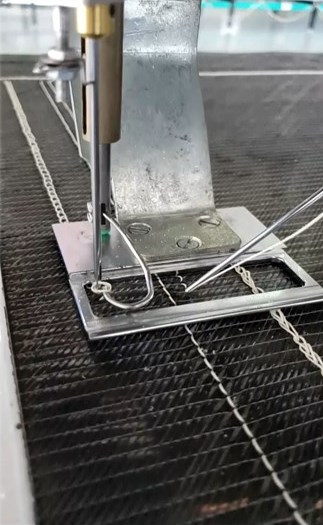FAA-funded MSU research program to address resin infusion needs in aerocomposites market
Phase I of the Mississippi State University Advanced Composites Institute’s multi-year program seeks industry feedback to identify market satisfaction gaps.

Mississippi State University’s robotic stitching machine, at its Marvin B. Dow Stitched Composites Development Center, features an eight-foot reach by 40-foot X-axis travel. Photo Credit: Mississippi State University
Begun in September 2020, a multi-year, multi-phase research program partially funded by the FAA and conducted by the (ACI, Starkville, Miss., U.S.) aims to identify and meet needs within resin infusion technology for aerospace applications.
In Phase I of the program, which takes place through October 2021, ACI is performing a technology readiness assessment for stitched and unstitched resin infusion. This includes both a literature survey by ACI, as well as a voice of the customer analysis involving feedback from suppliers, fabricators, OEMs and others within the aerospace composites value chain.
According to Dr. Wayne Huberty, technical director of research at ACI, “We’re talking to people up and down the value chain and learning about problems they may be having in resin infusion for aerospace. Through that, we’re building up a database of information, and as we start seeing patterns and repetitions, the goal is to build a sort of ‘Top 10’ list of the most important and least satisfied needs to address through further research and development. In this way, we at ACI can really focus on what the industry as a whole says is the most important and can actually quantify any market satisfaction gaps that we identify.”
After the initial market research portion of the project is completed, Huberty says that ACI will begin building and testing parts based on the results, with a focus on producing large, full-scale parts. This research, he adds, as well as the anonymous market intel, will be sent to and will hopefully be of value to the companies involved, as well as informing the next phases of ACI’s work.
The FAA supports this work under its , which focuses on ensuring up-and-coming materials systems and manufacturing technologies are rigorously evaluated for full understanding of potential advantages and disadvantages.
Microcracking, bonding and beyond
In Phase II of the program, set to begin late 2021, ACI will be targeting issues in laminate microcracking — “one of the big issues that has been identified already for stitched resin in composites,” Huberty notes. “We plan to evaluate and define the causes of microcracking within stitched resin infused laminates and illuminate what the most important factors are that need to be addressed.”

Stitched resin infusion (SRI) technology combines strategically placed robotic stitching with vacuum-assisted resin transfer molding (VARTM) to offer 3D complexity while increasing strength and toughness. Photo Credit: Mississippi State University
Along with Phase II, ACI will also evaluate bonding of stitched resin infused parts. After seeking industry feedback on the most important topics to address in this field, ACI will fabricate and test structures based on the collected data.
“Ultimately, we’re trying to move infusion further, and to do that, we’ll need industrial partners to work with us,” Huberty says. “We’d be happy to talk to partners interested in donating materials, or time, or expertise, or who have any specific parts they would like to contribute for evaluation.”
Through this and complementary research, the ACI is striving to demonstrate real-world utility and benefits of resin infusion in multiple market segments, adds Dr. Christopher Bounds, ACI director. “The proven benefits of resin infusion are astonishing; no one can argue with 98% reduction in parts, or 75% cost reduction,” he says. “When you add reinforcing stitches to the mix, and see a 60% increase in strength and 1,000% increase in toughness, you’re looking at transformational technology.” The ACI has shifted gears to demonstrate automated high-rate manufacturability of this technology at production scale.
The ACI is also establishing a High-Rate Resin Infusion Manufacturing (HiRIM) training academy to arm the workforce with the necessary skills to support this transformation. Bounds adds, “We know the technology works at the current scale; that’s been proven. What we’re focused on now is certification, demonstration of automation to maximize rates, and training the workforce in preparation for broader adoption in diverse markets.”
For more information or to get involved, please reach out to Huberty at whuberty@aci.msstate.edu.
Related Content
Revisiting the double vacuum debulk process
Evolution of the double vacuum debulk (DVD) process over the years continues to advance its “near autoclave quality” for low-void, highly compacted repair patches.
Read MoreModular, curved racing track design enabled by composites and adaptive molds
X-Track worked with bespline to develop an easy-to-install, reusable, customizable composite sandwich panel alternative to dirt BMX and motorcross tracks.
Read MoreWe4Ce designs rotor blades for TouchWind’s floating one-piece rotor turbine
Tiltable, liftable one-piece composite rotor design aims to withstand storm-force winds, boost energy yield and enable more compact offshore wind farms.
Read MoreMel Composites infusion strategy enables Sasga Yachts fiberglass hull designs
Mel’s ongoing partnership culminates in the development of the Menorquín 42 and Menorquín 54 motor yachts, as well as extension of Sasga’s capacity for 68-foot-length boats.
Read MoreRead Next
Ultrasonic welding for in-space manufacturing of CFRTP
Agile Ultrasonics and NASA trial robotic-compatible carbon fiber-reinforced thermoplastic ultrasonic welding technology for space structures.
Read MoreScaling up, optimizing the flax fiber composite camper
Greenlander’s Sherpa RV cab, which is largely constructed from flax fiber/bio-epoxy sandwich panels, nears commercial production readiness and next-generation scale-up.
Read MoreCutting 100 pounds, certification time for the X-59 nose cone
Swift Engineering used HyperX software to remove 100 pounds from 38-foot graphite/epoxy cored nose cone for X-59 supersonic aircraft.
Read More.jpg;width=70;height=70;mode=crop)












